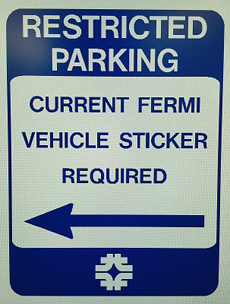Changes to parking rules
 |
| Pay attention to the new signage in the Wilson Hall and Feynman Computing Center parking areas. Photo courtesy of Jody Federwitz, ESH&Q |
Safety and security are important to Fermilab, and restricted parking is a part of the laboratory's Security Plan. Next week you will notice changes in the parking areas near Wilson Hall and the Feynman Computing Center. These changes, in keeping with the Security Plan and related DOE requirements, will allow us to maintain a safe and secure parking arrangement while alleviating enforcement problems we have seen over the last several months.
Hang tags
Starting Monday, March 30, you will no longer need to display a hang tag when parking in restricted areas. To park in a restricted parking area spot, marked by the sign above, you need only a Fermilab-issued vehicle sticker. These stickers are available to any lab employee through the Key and ID Office on the ground floor of Wilson Hall. The expiration date of the sticker coincides with the month and year your Fermilab ID card expires.
If you do not renew your sticker and park in a restricted area, you will receive a citation. If you sell your car or purchase a new one, you can easily get a new sticker from the Key and ID Office.
Long-term parking
Fermilab has designated long-term parking spots for employees on business travel. Employees who will be away from the lab longer than two weeks and would like to leave their vehicles at the laboratory must use the long-term parking lot located in the Village. Employees can park in a satellite location if they will be on travel for two weeks or less. These spots are located at CDF, DZero Outback, SiDet and the Wilson Hall overflow parking lot located at the Lederman Science Center. The reasons for these special parking areas are to keep vehicles out of the way of lab operations and to identify the owners so these vehicles aren't considered abandoned. To park in these spots, fill out a long-term parking form and take it to the Communication Center on the Wilson Hall ground floor.
How long may I park here?
Another change (watch for the signs to be updated) is that the one-hour parking area on the east side of Wilson Hall will become two-hour parking. However, spots in the front horseshoe will remain one-hour parking spots.
Handicap parking
To park in the handicap spots on site, you must have a hang tag or license plate issued by the state of Illinois. Be aware that some of the handicap parking spots also require a vehicle sticker.
Car pool parking
There are now six car pool spaces outside Wilson Hall. We have also added three new car pool spaces at Feynman Computing Center.
Anyone who carpools can use the car pool parking spaces, even if you drop off a spouse or co-worker at another building on site.
Learn more about the new parking rules on the Traffic Safety Subcommittee Web page.
—Martha Michels, head of ESH&Q
|